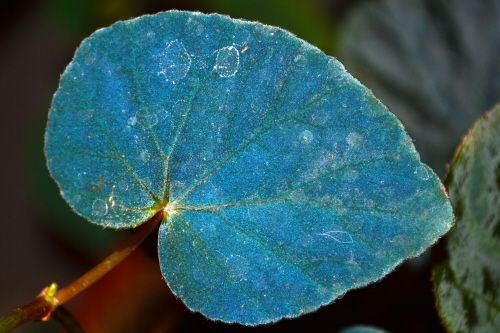Plant Evolution: Iridescent Blue Leaves To Survive In Forest Undergrowth

We all grow up learning that green is the color of leaves. Or yellow, red, orange and other such shades when it is fall and they turn into a riot of colors. But blue? And not just an ordinary blue, but blue that seems to shimmer and glow?
Several species of begonia are popular as houseplants, not only for their decorative leaves and flowers, but also because they don’t require direct sunlight while indoors. Some of the over 1,500 species of begonia have been known to show an iridescent blue sheen to their leaves, and scientists may have finally understood why.
Many begonia grow near the undergrowth of tropical rainforests, where the tree canopy is usually quite thick and lets through very little light, forcing plants under the canopy to harvest every little bit of light they can find.
A team of researchers at the University of Bristol in the United Kingdom, led by Dr. Heather Whitney, saw that the begonia “leaves only developed a blue sheen when put in almost dark conditions and in bright light the sheen slowly disappeared.”
Whitney’s team found that the begonia plants carried out photosynthesis — converting light to energy — using a different type of chloroplast than most plants whose leaves are green.
Matt Jacobs, a PhD student at the university’s School of Biological Sciences and first author of a research paper on the subject, said in a statement: “We discovered under the microscope, individual chloroplasts in these leaves reflected blue light brightly, almost like a mirror. Looking in more detail by using a technique known as electron microscopy, we found a striking difference between the ‘blue’ chloroplasts found in the begonias, also known as ‘iridoplasts’ due to their brilliant blue iridescent coloration, and those found in other plants. The inner structure had arranged itself into extremely uniform layers just a few 100 nanometers in thickness, or a 1,000th the width of human hair.”
The team collaborated with photonics researchers at the university who studied the nanostructure of the leaves and predicted they would absorb more green light and reflect all of the blue light. This is important because leaves usually absorb all of the blue and red wavelengths of light, while the green is reflected, which gives them their color. If a leaf absorbed the green and reflected all the blue, its color would change accordingly.
Research carried out by a team at the University of Essex confirmed that iridoplasts performed better at photosynthesis than normal chloroplasts in very low light levels.
All this together suggests that begonia that grows far below the forest canopy, has evolved to iridoplasts to “scavenge the remaining green light in the understory canopy” that is reflected by the taller trees.
The research paper titled “Photonic multilayer structure of Begonia chloroplasts enhances photosynthetic efficiency” appeared Monday in the journal Nature Plants.
© Copyright IBTimes 2025. All rights reserved.





















